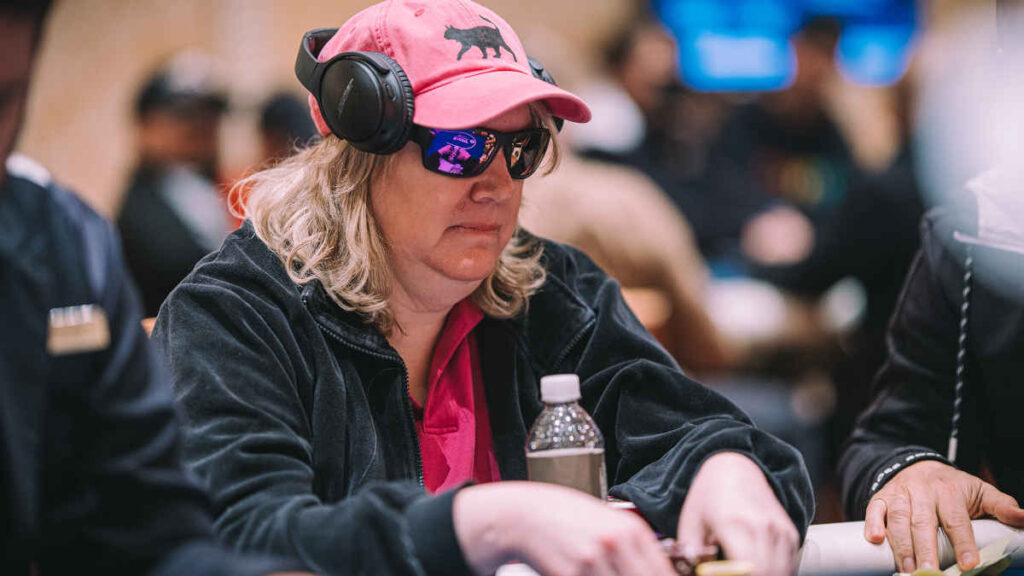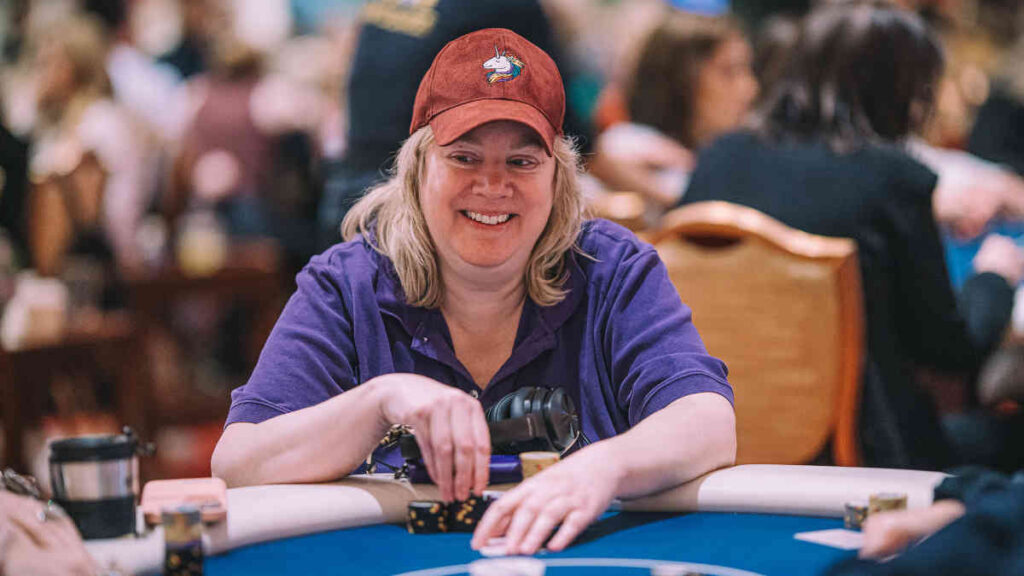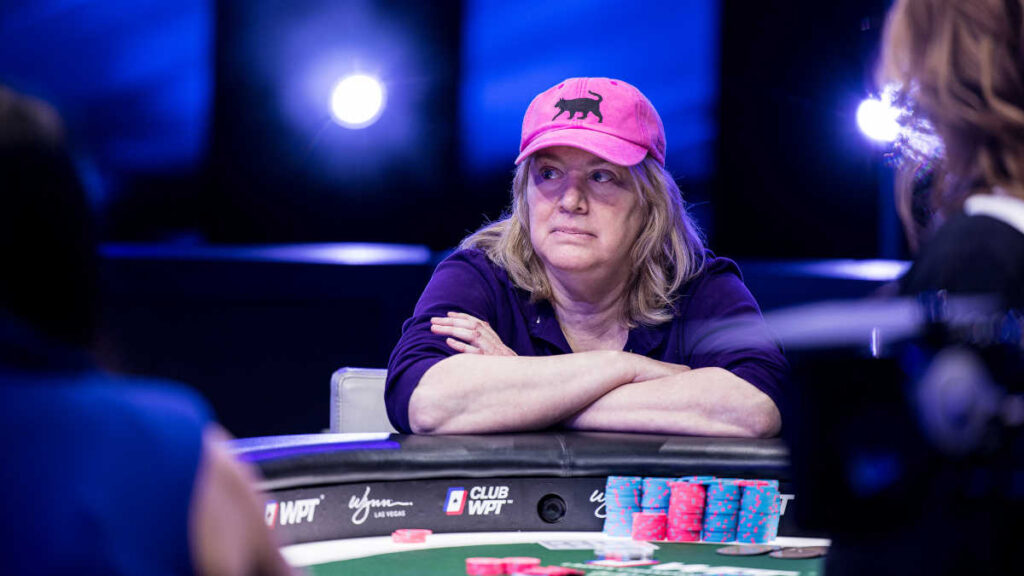Images courtesy of World Poker Tour
Tough, tactical, and timeless—Kathy Liebert has been outplaying the competition long before poker became mainstream.
In this edition of Inside the Poker Circles, drawn from Between the Blinds: Interviewing Poker Professionals by Sara O’Connor (coming soon), we highlight a true pioneer of the game.
With millions in tournament earnings, a WSOP bracelet, and a fearless presence at the table, Liebert has built a legacy through consistency, intelligence, and quiet dominance. She’s gone toe-to-toe with the game’s fiercest competitors, proving again and again that substance always outlasts hype.
In this interview, Liebert reflects on the moments that defined her journey, how she’s adapted through decades of change, and the mindset that continues to fuel her success. This is Between the Blinds.
You began playing poker as a leisure activity since you were 12, correct?
I started playing poker as a child in home games with the family, playing with change and small limits. It was fun. I didn’t play too much until I moved to Colorado where I rediscovered poker in Blackhawk and Central City, which had $5 Limit games.
After playing in Colorado in home games and casinos, my friends told me about a tournament in Las Vegas at the Orleans Casino. That was 1994. I went and in my first two weeks, I chopped two different tournaments heads up and won $34,000 playing them! So, I was hooked!
I started playing more tournaments, traveling to California and Vegas, and continued to have results. Because of this, I continued traveling and playing tournaments and poker became my passion and career.
What levels have you played, and which is your favorite and why?
I have played at so many different levels.
When I first started, I played mostly Limit games like, $5 Limit in Colorado. Then I moved up and played $4-$8 and $10-20, respectively.
I started playing mostly low buy-in tournaments in 1994; the buy-ins were generally $100-$500. After having success that first year, I was traveling and playing tournaments ever since and the buy-in range increased over time.
In the early years, there weren’t many tournaments with buy-ins above $500 or $1,000. However, PartyPoker started and guaranteed a one million tournament in 2002.
You could qualify online by playing $8 sit-and-go’s for a tournament that, if you won, awarded you an $8,000 seat to the tournament on a cruise ship. Mike Sexton and Tom McEvoy kept telling me I should play it, but I was reluctant to go. They finally convinced me to go, and I won it.

It was one million guaranteed for first place, but they didn’t get as many players as expected. You could win a seat online or buy-in for $8,000. First prize was a million and second prize was $93,000.
When we made the final table, the prizes for the lower spots were very low compared to first place. We wound up chopping some of the money 5-handed and then 3-handed to lock up a good amount of money, so the discrepancy wasn’t so huge.
I started playing Limit tournaments in 1994. Then, they had satellites for a game I hadn’t played before, No Limit Texas Hold’em. I hadn’t played No Limit, but I remember playing a satellite for the $500 Main Event at the Orleans after I had success in the Limit Hold’em and Omaha 8 tournaments.
There were WSOP Main Event players and winners in the satellite and I won it. I also finished 4th in the tournament so I started playing more No Limit tournaments after that, which I started to like better than Limit.
How did you decide when it was time to raise the stakes and play at a higher level?
After having success in the lower buy-in tournaments right away, I started playing more of the larger buy-ins. It wasn’t until after the PartyPoker tournament in 2002 that the WPT started and many bigger buy-in tournaments were offered.
Before WPT, most tournaments were series with buy-ins of $100-$500 and the WSOP was the only series with mostly big buy-ins. So, I started playing the WPT, which had buy-ins of mostly $5,000 and $10,000 in 2002, and had success in those. So, I continued to play WPT tournaments.
Where is your favorite place to play and why?
While I think the tournaments outside of Vegas are great like the Hard Rock in Florida, I like being at home the most. I have traveled a lot in the past, but these days, I prefer to stay in Vegas and not travel too much. I still like to go to Florida to play at the Hard Rock.
Do you play cash games, tournaments, or both?
I had early success in tournaments, so I focused and played mostly tournaments and rarely played cash games. Usually when I play cash, I play more for fun. I have played smaller stakes just to have fun and enjoy it.
There are pros and cons to both. I enjoyed playing cash games occasionally to be sociable; it was not to play seriously or to make a living.
How do you not let past success affect your current play?
Sometimes I’m not as focused as I used to be, i.e., not as hungry or “eye of the tiger”, as in my younger days, but I do want to be competitive still. Depending on the table and tournament, sometimes I’m less competitive and focused than others.
If the table is friendly and engaging, I usually am too. There are times when I want to play my best and focus, but I like to enjoy the experience and the people sometimes too.
What’s one thing you wish people knew about playing Texas Hold’em cash games?
It can be sociable and friendly! It doesn’t have to be so competitive, quiet, and serious. Try to have fun too; be friendly, and do not be a bad winner or bad loser.
From your experience, what are the most common tells or behaviors that give away a player’s hand strength?
Many times, people do act differently when they are strong or weak. So, it makes sense to take a little more time and be thoughtful whether you’re strong or weak.

I think most of us do have tells with how we act and often give clues to people who pay attention if we are stronger or weaker. So, it makes sense to try to be more aware and not give away too much with how we act.
Try not to act differently depending on the strength of your poker hand. It’s not easy to take similar actions and time regardless of hand strength. This is something I still need to think about and be aware of. This can be a challenge for a lot of players.
What is your advice for bankroll management?
Most people play too high for their bankroll. It is better to play lower than you can afford and not have too much pressure or negative emotions if losing. So, play what you can afford to lose.
What advice would you give to players about table etiquette and interacting with dealers and players?
It’s best to be friendly and nice and for people to enjoy playing with you. Don’t cause others to feel badly regardless of who is winning or losing. It’s better for the game not to be a sore winner or a sore loser. Also, don’t insult or rub it in if you’re winning or getting lucky or unlucky.
Some people are not good at this. I have sometimes said something after getting a bad beat or getting beat by a bad play, but it’s much better not to say anything negative, critical, or condescending, regardless of whether someone made a bad play to beat you or not.


